问题导读:
1、如何设计每日新增设备明细表?
2、如何使用每日新增设备表?
3、如何设计用户留存主题表?
4、如何设计留存用户数表?
上一篇:大数据项目之电商数仓(总结)(九):用户行为数据仓库
第7章 需求二:用户新增主题
首次联网使用应用的用户。如果一个用户首次打开某APP,那这个用户定义为新增用户;卸载再安装的设备,不会被算作一次新增。新增用户包括日新增用户、周新增用户、月新增用户。
7.1 DWS层(每日新增设备明细表)
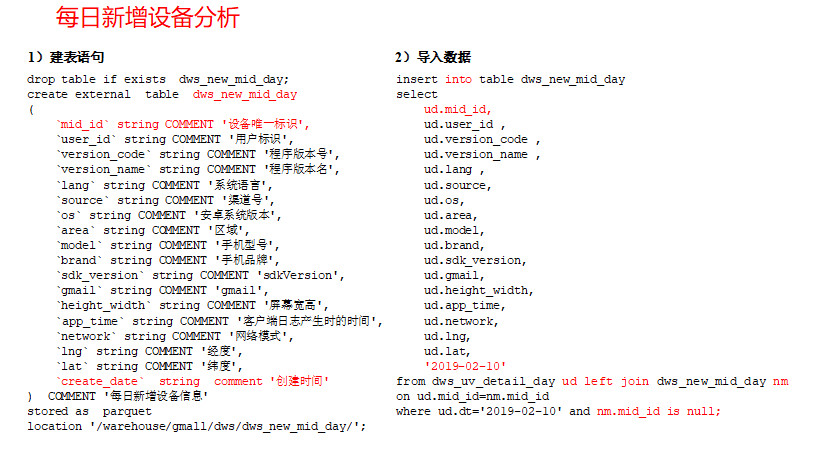
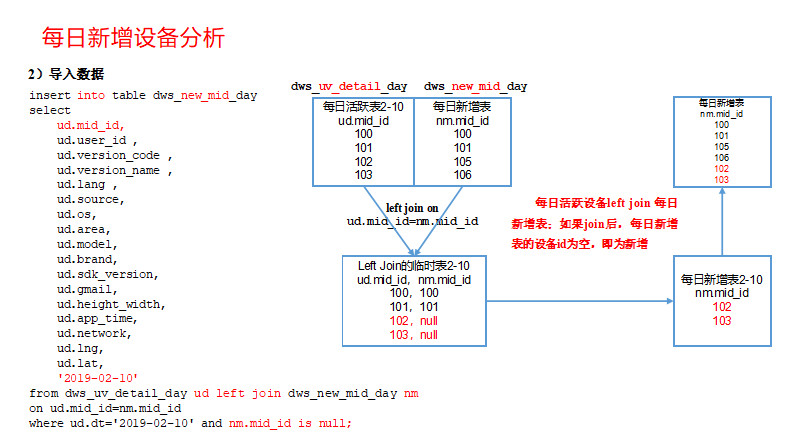
1)建表语句
- hive (gmall)>
- drop table if exists dws_new_mid_day;
- create external table dws_new_mid_day
- (
- `mid_id` string COMMENT '设备唯一标识',
- `user_id` string COMMENT '用户标识',
- `version_code` string COMMENT '程序版本号',
- `version_name` string COMMENT '程序版本名',
- `lang` string COMMENT '系统语言',
- `source` string COMMENT '渠道号',
- `os` string COMMENT '安卓系统版本',
- `area` string COMMENT '区域',
- `model` string COMMENT '手机型号',
- `brand` string COMMENT '手机品牌',
- `sdk_version` string COMMENT 'sdkVersion',
- `gmail` string COMMENT 'gmail',
- `height_width` string COMMENT '屏幕宽高',
- `app_time` string COMMENT '客户端日志产生时的时间',
- `network` string COMMENT '网络模式',
- `lng` string COMMENT '经度',
- `lat` string COMMENT '纬度',
- `create_date` string comment '创建时间'
- ) COMMENT '每日新增设备信息'
- stored as parquet
- location '/warehouse/gmall/dws/dws_new_mid_day/';
2)导入数据
用每日活跃用户表Left Join每日新增设备表,关联的条件是mid_id相等。如果是每日新增的设备,则在每日新增设备表中为null。
- hive (gmall)>
- insert into table dws_new_mid_day
- select
- ud.mid_id,
- ud.user_id ,
- ud.version_code ,
- ud.version_name ,
- ud.lang ,
- ud.source,
- ud.os,
- ud.area,
- ud.model,
- ud.brand,
- ud.sdk_version,
- ud.gmail,
- ud.height_width,
- ud.app_time,
- ud.network,
- ud.lng,
- ud.lat,
- '2020-10-14'
- from dws_uv_detail_day ud left join dws_new_mid_day nm on ud.mid_id=nm.mid_id
- where ud.dt='2020-10-14' and nm.mid_id is null;
3)查询导入数据
- hive (gmall)> select count(*) from dws_new_mid_day ;
4)导入数据脚本
- [kgg@hadoop102 bin]$ vi dws_new_log.sh
- #!/bin/bash
-
- # 定义变量方便修改
- APP=gmall
- hive=/opt/module/hive/bin/hive
- hadoop=/opt/module/hadoop-2.7.2/bin/hadoop
-
- # 如果是输入的日期按照取输入日期;如果没输入日期取当前时间的前一天
- if [ -n "$1" ] ;then
- do_date=$1
- else
- do_date=`date -d "-1 day" +%F`
- fi
-
- echo "===日志日期为 $do_date==="
- sql="
- insert into table "$APP".dws_new_mid_day
- select
- ud.mid_id,
- ud.user_id ,
- ud.version_code ,
- ud.version_name ,
- ud.lang ,
- ud.source,
- ud.os,
- ud.area,
- ud.model,
- ud.brand,
- ud.sdk_version,
- ud.gmail,
- ud.height_width,
- ud.app_time,
- ud.network,
- ud.lng,
- ud.lat,
- '$do_date'
- from "$APP".dws_uv_detail_day ud left join "$APP".dws_new_mid_day nm on ud.mid_id=nm.mid_id
- where ud.dt='$do_date' and nm.mid_id is null;
- "
-
- $hive -e "$sql"
7.2 ADS层(每日新增设备表)
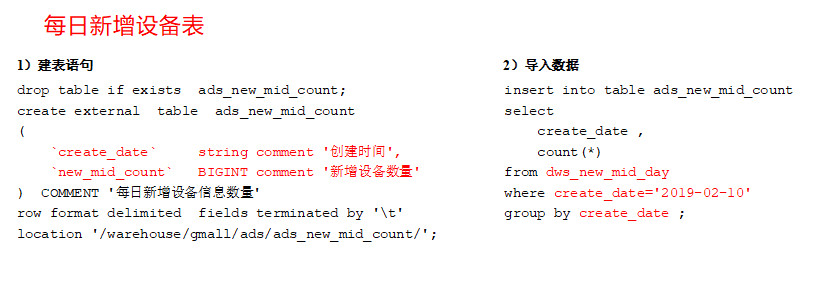
1)建表语句
- hive (gmall)>
- drop table if exists ads_new_mid_count;
- create external table ads_new_mid_count
- (
- `create_date` string comment '创建时间',
- `new_mid_count` BIGINT comment '新增设备数量'
- ) COMMENT '每日新增设备信息数量'
- row format delimited fields terminated by '\t'
- location '/warehouse/gmall/ads/ads_new_mid_count/';
2)导入数据
- hive (gmall)>
- insert into table ads_new_mid_count
- select
- create_date,
- count(*)
- from dws_new_mid_day
- where create_date='2020-10-14'
- group by create_date;
3)查询导入数据
- hive (gmall)> select * from ads_new_mid_count;
4)导入数据脚本
- [kgg@hadoop102 bin]$ vim ads_new_log.sh
- #!/bin/bash
-
- # 定义变量方便修改
- APP=gmall
- hive=/opt/module/hive/bin/hive
- hadoop=/opt/module/hadoop-2.7.2/bin/hadoop
-
- # 如果是输入的日期按照取输入日期;如果没输入日期取当前时间的前一天
- if [ -n "$1" ] ;then
- do_date=$1
- else
- do_date=`date -d "-1 day" +%F`
- fi
-
- echo "===日志日期为 $do_date==="
- sql="
- insert into table "$APP".ads_new_mid_count
- select
- create_date,
- count(*)
- from "$APP".dws_new_mid_day
- where create_date='$do_date'
- group by create_date;"
-
- $hive -e "$sql"
第8章 需求三:用户留存主题
8.1 需求目标
8.1.1 用户留存概念

8.1.2 需求描述
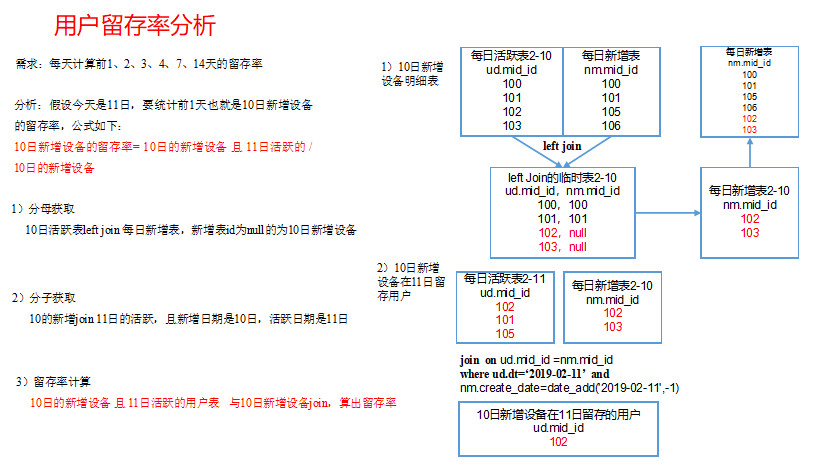
8.2 DWS层
8.2.1 DWS层(每日留存用户明细表)
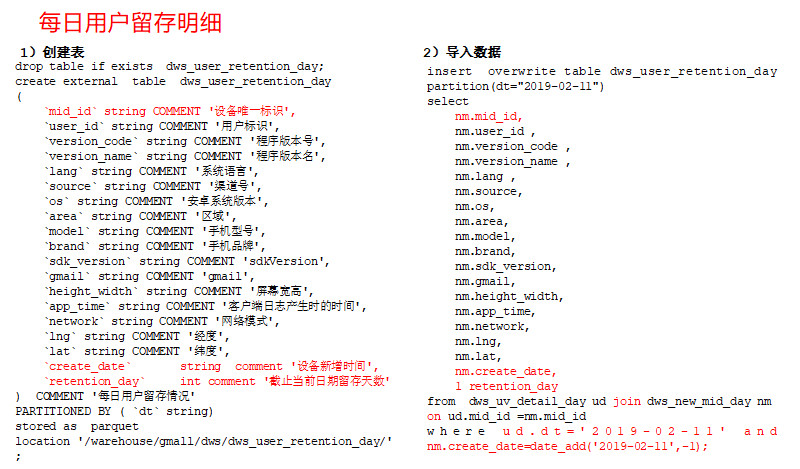
1)建表语句
- hive (gmall)>
- drop table if exists dws_user_retention_day;
- create external table dws_user_retention_day
- (
- `mid_id` string COMMENT '设备唯一标识',
- `user_id` string COMMENT '用户标识',
- `version_code` string COMMENT '程序版本号',
- `version_name` string COMMENT '程序版本名',
- `lang` string COMMENT '系统语言',
- `source` string COMMENT '渠道号',
- `os` string COMMENT '安卓系统版本',
- `area` string COMMENT '区域',
- `model` string COMMENT '手机型号',
- `brand` string COMMENT '手机品牌',
- `sdk_version` string COMMENT 'sdkVersion',
- `gmail` string COMMENT 'gmail',
- `height_width` string COMMENT '屏幕宽高',
- `app_time` string COMMENT '客户端日志产生时的时间',
- `network` string COMMENT '网络模式',
- `lng` string COMMENT '经度',
- `lat` string COMMENT '纬度',
- `create_date` string comment '设备新增时间',
- `retention_day` int comment '截止当前日期留存天数'
- ) COMMENT '每日用户留存情况'
- PARTITIONED BY (`dt` string)
- stored as parquet
- location '/warehouse/gmall/dws/dws_user_retention_day/';
2)导入数据(每天计算前1天的新用户访问留存明细)
- hive (gmall)>
- insert overwrite table dws_user_retention_day
- partition(dt="2020-10-15")
- select
- nm.mid_id,
- nm.user_id ,
- nm.version_code ,
- nm.version_name ,
- nm.lang ,
- nm.source,
- nm.os,
- nm.area,
- nm.model,
- nm.brand,
- nm.sdk_version,
- nm.gmail,
- nm.height_width,
- nm.app_time,
- nm.network,
- nm.lng,
- nm.lat,
- nm.create_date,
- 1 retention_day
- from dws_uv_detail_day ud join dws_new_mid_day nm on ud.mid_id=nm.mid_id where ud.dt='2020-10-15' and nm.create_date=date_add('2020-10-15',-1);
3)查询导入数据(每天计算前1天的新用户访问留存明细)
- hive (gmall)> select count(*) from dws_user_retention_day;
8.2.2 DWS层(1,2,3,n天留存用户明细表)
1)导入数据(每天计算前1,2,3,n天的新用户访问留存明细)
- hive (gmall)>
- insert overwrite table dws_user_retention_day
- partition(dt="2019-02-11")
- select
- nm.mid_id,
- nm.user_id,
- nm.version_code,
- nm.version_name,
- nm.lang,
- nm.source,
- nm.os,
- nm.area,
- nm.model,
- nm.brand,
- nm.sdk_version,
- nm.gmail,
- nm.height_width,
- nm.app_time,
- nm.network,
- nm.lng,
- nm.lat,
- nm.create_date,
- 1 retention_day
- from dws_uv_detail_day ud join dws_new_mid_day nm on ud.mid_id =nm.mid_id
- where ud.dt='2019-02-11' and nm.create_date=date_add('2019-02-11',-1)
-
- union all
- select
- nm.mid_id,
- nm.user_id ,
- nm.version_code ,
- nm.version_name ,
- nm.lang ,
- nm.source,
- nm.os,
- nm.area,
- nm.model,
- nm.brand,
- nm.sdk_version,
- nm.gmail,
- nm.height_width,
- nm.app_time,
- nm.network,
- nm.lng,
- nm.lat,
- nm.create_date,
- 2 retention_day
- from dws_uv_detail_day ud join dws_new_mid_day nm on ud.mid_id =nm.mid_id
- where ud.dt='2019-02-11' and nm.create_date=date_add('2019-02-11',-2)
-
- union all
- select
- nm.mid_id,
- nm.user_id,
- nm.version_code,
- nm.version_name,
- nm.lang,
- nm.source,
- nm.os,
- nm.area,
- nm.model,
- nm.brand,
- nm.sdk_version,
- nm.gmail,
- nm.height_width,
- nm.app_time,
- nm.network,
- nm.lng,
- nm.lat,
- nm.create_date,
- 3 retention_day
- from dws_uv_detail_day ud join dws_new_mid_day nm on ud.mid_id =nm.mid_id
- where ud.dt='2019-02-11' and nm.create_date=date_add('2019-02-11',-3);
2)查询导入数据(每天计算前1,2,3天的新用户访问留存明细)
- hive (gmall)> select retention_day , count(*) from dws_user_retention_day group by retention_day;
8.2.3 Union与Union all区别
1)准备两张表
- tableA tableB
- id name score id name score
- 1 a 80 1 d 48
- 2 b 79 2 e 23
- 3 c 68 3 c 86
2)采用union查询
- select name from tableA
- union
- select name from tableB
- 查询结果
- name
- a
- d
- b
- e
- c
3)采用union all查询
- select name from tableA
- union all
- select name from tableB
- 查询结果
- name
- a
- b
- c
- d
- e
- c
4)总结
(1)union会将联合的结果集去重,效率较union all差
(2)union all不会对结果集去重,所以效率高
8.3 ADS层
8.3.1 留存用户数

1)建表语句
- hive (gmall)>
- drop table if exists ads_user_retention_day_count;
- create external table ads_user_retention_day_count
- (
- `create_date` string comment '设备新增日期',
- `retention_day` int comment '截止当前日期留存天数',
- `retention_count` bigint comment '留存数量'
- ) COMMENT '每日用户留存情况'
- row format delimited fields terminated by '\t'
- location '/warehouse/gmall/ads/ads_user_retention_day_count/';
2)导入数据
- hive (gmall)>
- insert into table ads_user_retention_day_count
- select
- create_date,
- retention_day,
- count(*) retention_count
- from dws_user_retention_day
- where dt='2020-10-15'
- group by create_date,retention_day;
3)查询导入数据
- hive (gmall)> select * from ads_user_retention_day_count;
8.3.2 留存用户比率
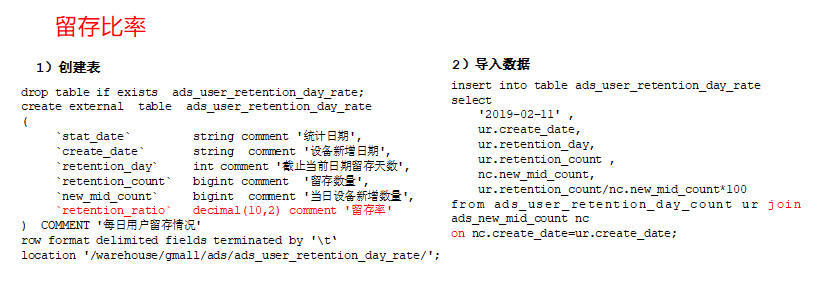
1)建表语句
- hive (gmall)>
- drop table if exists ads_user_retention_day_rate;
- create external table ads_user_retention_day_rate
- (
- `stat_date` string comment '统计日期',
- `create_date` string comment '设备新增日期',
- `retention_day` int comment '截止当前日期留存天数',
- `retention_count` bigint comment '留存数量',
- `new_mid_count` bigint comment '当日设备新增数量',
- `retention_ratio` decimal(10,2) comment '留存率'
- ) COMMENT '每日用户留存情况'
- row format delimited fields terminated by '\t'
- location '/warehouse/gmall/ads/ads_user_retention_day_rate/';
2)导入数据
- hive (gmall)>
- insert into table ads_user_retention_day_rate
- select
- '2020-10-14',
- ur.create_date,
- ur.retention_day,
- ur.retention_count,
- nc.new_mid_count,
- ur.retention_count/nc.new_mid_count*100
- from ads_user_retention_day_count ur join ads_new_mid_count nc
- on nc.create_date=ur.create_date;
3)查询导入数据
- hive (gmall)>select * from ads_user_retention_day_rate;
最新经典文章,欢迎关注公众号
|
 /2
/2 